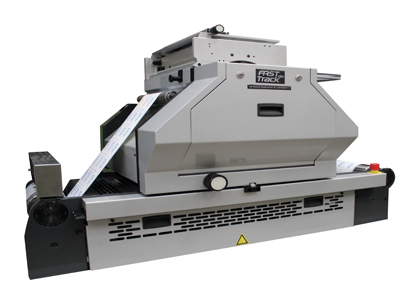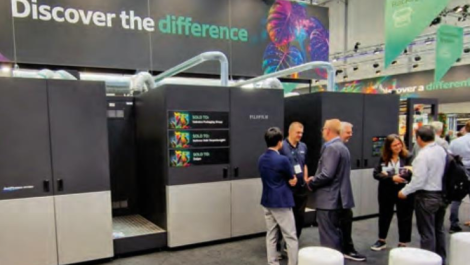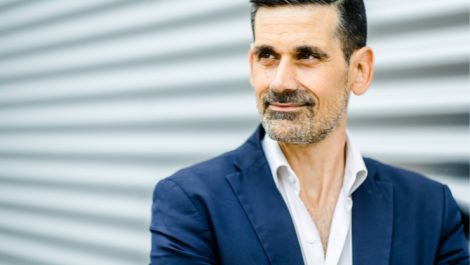ABG’s new FAST Track die-cutting module offers speeds up to 150 m/min
The term ‘finishing’ is perhaps a bit misleading when it comes to labels and folding cartons. In many ways, it is after the printing that the real ‘fun’ starts, or rather the process of adding value begins in earnest. Neel Madsen looks at finishing processes ahead of drupa.
Some digital label presses offer a certain amount of finishing inline such as laser-cutting, slitting and rewinding. Most printed rolls, however, will be transferred to an offline finishing unit where any number of processes add value to the product and complete the design. Very few printers run separate finishing machines inline with the digital press although this is beginning to change. Either way, the name of the game is fast turnaround and less waste whilst giving customer that little extra je ne sais quoi.
‘Changeovers aren’t complete until you’re making good product. With faster set ups and fewer adjustments you can spend your time adding value to your labels, setting you and your customers apart from the competition,’ commented David Grewis of Delta ModTech.
Faster die-cutting
With a vast amount of converting systems installed worldwide, AB Graphic is the market leader when it comes to finishing digitally printed labels. Its Digicon and Digicon Lite systems can be configured to suit any production line.
Most recently, the company has unveiled its latest innovation developed for the Digicon 3 and to run inline with the new HP 8000 digital press. Billed as the world’s fastest semi-rotary die-cutting system, the FAST Track die module was first seen at Dscoop in Israel and the US in April, and will also be on show at drupa.
‘We are very proud of this world first,’ said sales director Tony Bell. ‘The FAST Track die can run at speeds of up 150 m/min in semi-rotary mode, with a repeat range of 250-508 mm. With digital presses running faster, and a trend towards inline finishing, there is a definite demand for higher speed die-cutting.’
In the spectrum
At drupa, Delta ModTech will be showing the Spectrum finishing line, a modular system that can be adjusted as needed when new customer demands present themselves.
The Spectrum converts webs with a width of up to 330 mm at a speed of maximum 152 m/min depending on the process. It is operated via a touchscreen interface and features total servo control for tight tolerance, digital registration. The system can run inline with the digital press using a buffer and comes with full rotary, semi-rotary and specialty cutting abilities like carton cutting and under-cutting with registration to a kiss-cut as standard, while the company’s own laser cutting module is offered as an option. A flexo print station with GEW curing is also part of the standard set up, with hot and coil foil, embossing and screen printing all modules that can be added.
Marketing coordinator David Grenwis explained that process modules can be easily added and removed, without causing major rebuilds or extensive changeovers. This means the machine can grow with the company as needed.
Running faster
Grafotronic, the Swedish manufacturer, has re-designed DCL2 digital converting line for higher speeds and maximum performance. Developed late last year, it features a new quick-change flexo unit with combined semi-rotary and rotary functions for varnish and spot varnish. Optional cold foil lamination is also available.
Capable of running at speeds up to 100 m/min, a new semi-rotary die-cutting unit die station has been developed to match the new faster digital presses. Any inventory of existing magnetic cylinders can be used, and the new Q-Load system enables the next job to be prepared while the machine is running. At job change, the old cylinder is removed onto a trolley and the new one slides in.
Each knife and counter knife in the Wifi-Slitting automatic knife positioning system is independently driven. This means that up to 15 knives can be set within 10 seconds, and cut down to the minimum cutting width of 15 mm.
On the new fully servo-driven semi-automatic turret rewinder, finished rolls can be unloaded and new cores prepared while the machine is running. The new Autocut automatic cutting system cuts the web when the roll is finished, and the machine then starts up a new cycle automatically. The Q-Shaft is a new rewind shaft solution that allows quick change between shaft sizes.
Intelligent converting
‘Ideally, a digital press should be able to run continuously with minimal operator involvement and without stops for set up and job changeovers. The solution we propose is what we call ‘intelligent converting’, a converting line that automatically separates multiple jobs on the same roll,’ said Søren Pedersen, chief commercial officer, Werosys.
Based in Allerød, in Denmark, Werosys was established in 2013. It offers the Concept and the Compact modular converting platforms, which can be integrated with the workflow via a management information system.
Mr Pedersen continued, ‘With our systems, you can run a series of jobs from one centralised PLC/HMI, whether it’s selecting varnish, importing the die-cut shape to the laser, adjusting the automatic knife system or set up the rewinding. The result is reduced waste, reduced costs, an optimised production and enhanced capacity.’
This philosophy of an automated production environment prompted the company to choose the Hyperion 929IPS anti-static system from Meech for its converting lines. The bars, which also allow easy integration and require minimal operator intervention, were a perfect fit with the company’s automation philosophy.
Bjarke Gerdes-Nielsen, CTO and founder, said, ‘The online monitoring capabilities of Meech’s technology fits perfectly with our full integration approach, where we are able to remote control and run diagnostics on machines from our site in Denmark via standard internet connection.’
Cutting cartons
Xeikon is launched a new flatbed die-cutting unit (the FDU) at drupa. This has been developed to aid efficient end to end printing and converting for folding carton printers.
The 2000 sheets per hour flatbed system handles sheet sizes from 400 x 400 mm up to 530 x 1000 mm and a maximum die-cut size of 490 x 700 mm. Substrate thickness can range from 160 to 890 microns for paper and cartonboard as well as microflute corrugated board, which means it can be used for completing offset as well as digital runs. (See also the Cover story on pp 20-21).
Kama’s new generation of ProCut 58 die-cutter for digitally printed sheets in the quarter-size format, either conventional or cut to size, is now available with a new sheet feeder, a modern touch panel and new software. The cutter is also now capable of handling format sizes up to 580 x 400 mm, which is 50 mm more than previously.
Important for its application in folding cartons is the AutoRegister system. Even sheets that are cut after they have been printed – for example sheets that are cut down from B2 to B3 – can be finished with the precision, and a performance of up to 6000 sheets per hour is achievable.
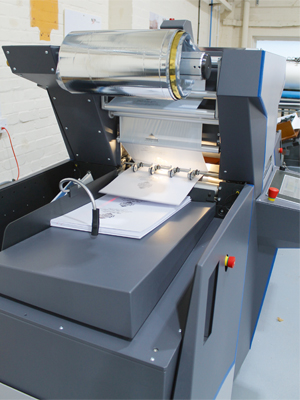
NXP Europe has installed the first DM-Liner Digital Foil machine in the UK
The company said that the re-launch of the ProCut 58 is the result of the growing demand for finished short runs, both for small format printing jobs and folding cartons. With these now being printed more often digitally, the flexible ProCut 58 Foil version covers a wide range of finishing applications and processing these short run orders can prove highly profitably as a result of the fast job changeovers.
Esko has announced a regrouping of its cutting table products into two new ‘families’, each with a range of sizes and configurations. These two distinct product ranges give customers a choice between the greatest flexibility for versatile and creative jobs (Kongsberg X), or the best productivity for efficient production runs (Kongsberg C).
Kongsberg X offers the flexibility of upgrading to add more cutting, creasing and milling tools as the business needs develop. Kongsberg C is the number one choice for short run production, building on the existing Kongsberg C line, which has been extended with smaller table sizes.
A new Auto Tool Adjust uses camera inspection and digital image processing to adjust the tool in the machine at the start of each job. When a new job requires a different tool, Auto Tool Adjust automates setting up that tool for the selected substrate. This new feature is backed up by the integration of a complete materials database.
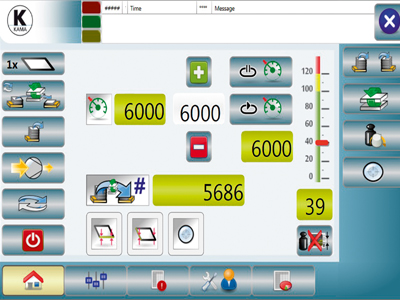
The new menu navigation and pictograms ensure operation of the Kama ProCut 58 is a straightforward process
Esko has also integrated its Kongsberg tables with Automation Engine via the new Device Manager for full workflow automation.
Cutting and creasing
Highcon has announced the introduction of the latest in its range of Euclid digital cutting and creasing machines for folding cartons and commercial printing. In light of the attention to B1 digital printing expected at drupa, the company will launch the Highcon Beam. According to the company, this machine will provide the ‘wow factor’ at the show. As the most productive unit in the portfolio, the Beam can finish up to 5000 B1 sheets per hour and features the Highcon Axis software built to handle variable data jobs.
Axis is a web to print system that offers a simplified process of ordering packaging online. Customers can browse different boxes on a phone or tablet. These can be personalised with print or finishing and a 3D proof is sent to the customer for approval. Once purchased, the system sends the order with all job information to the printer automatically. The software has been created with partners XMPie and Esko.
Also making its debut at drupa, the new Euclid III comes with the option of adding variable data and 3D modelling capabilities. The 3D module with Highcon’s Rapid Layer Manufacturing technology offers customers a wide range of capabilities. Models are created based on any type of substrate, including recycled board and even used offset makeready sheets.
Finally, the company will launch the Highcon Pulse as an entry level model. Capable of cutting and creasing the unit can run at 2000 sph in B2 format. The machine has a smaller footprint, but contains all the capabilities of the larger models in the portfolio.
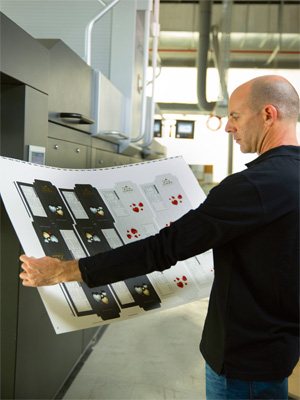
Scodix has introduced a range of new embellishment features
Making it sparkle
Foiling, tactile and/or spot varnishing, and other special effects play an important role in achieving shelf standout on folding cartons, and there are a number of ways this can be done.
Running live at drupa will be a new addition to MGI’s JETvarnish 3D digital enhancement product portfolio. The JETvarnish 3D Evolution, a B1+ scalable sheetfed digital enhancement press, features a modular and field upgradeable architecture, digital foiling and an upgradeable inkjet expansion system, with three available substrate size options ranging from 52 x 120cm to 64 x 120cm and 75 x 120 cm.
Designed for packaging, the machine offers a blend of digital embellishments in the form of spot varnish, 3D raised varnish and digitally embossed foil, all in one pass. It incorporates pallet stacking, automated inkjet printhead cleaning, automatic feeding system as well as artificial intelligence-based sheet registration system.
Scodix is also launching a new digital enhancement press for the folding carton market at drupa. The E106 press prints B1 size sheets at speeds up to 4000 per hour. Delivering multiple print enhancements in one platform, the new machine features a number of Scodix technologies, including Sense, Spot, Braille, Digital Embossing, Variable Data and Foil. The company has partnered with Compact Foilers Ltd, which developed the foil system, and MABEG Systems GmbH for the paper handling system.
The company has also just introduced Scodix Crystals, a 3D dimensional effect that simulates custom jewellery, and Scodix Cast & Cure for holographic effects.
Digital foiling
The latest innovation from Kurz is Digital Metal, a foiling process that combines digital printing with a coating- and metal-transfer process to create metallised surfaces. The process is relatively simple. It involves printing a black layer on a digital press then running the sheets through a DM-Liner Digital Foil machine, which heats up the black layer and laminates it together with the foil. After detaching the carrier film, the sheet can then go back in the digital press to be printed over-printed with CMYK. The over-print creates metallic colours to offer a kaleidoscope of tints. The foils used are silver, gold, diffraction (for an iridescent look) or holographic.
NXP Europe has installed the first DM-Liner in the UK. The machine was first introduced to the market by Leonhard Kurz in late 2014, and is now in operation at the Tunbridge Wells-based print company.
‘We are looking to move into high end personalised and luxury packaging, and the DM-Liner gives us the opportunity to add value for our clients without a big investment for them,’ explained sales manager Nick Faux. He described the machine as ‘a real door opener’ that has given the company a route into a market they could previously not reach. ‘When customers see what we can do with Digital Metal, they are get very excited. It is new and different, but very cost-effective.’
The technology, which can be seen at drupa, won the EDP Award for Best Special Solutions Provider in 2015.

